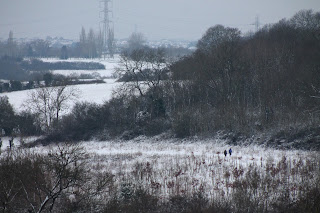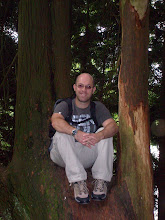As many of you will know from my last post I have
recently been lucky enough to be involved with the first ever Pseudomyxoma
International Patient Forum held at Basingstoke and North Hampshire’s Arc
Conference Centre.
It was a fantastic day that allowed fellow PMP
patients to gather and obtain up to date, quality information direct from the
leading experts in the world. It also allowed so many sufferers’s who have
talked via forum’s, email and the web to finally meet face to face.I know many
of whom attended a meal together the evening before the forum as a social event
sponsored by the Pseudomyxoma Survivor charity.
The event started with a buffet lunch at the Arc
Centre and allowed time for around 100 delegates to meet, have a chat and also
look at the stands. The local press and hospital photographers were onsite
covering the event.
Dr. Paul Sugarbaker, Tom Cecil, Brendan Moran and some of the Basingstoke team ( plus me!)
The meeting started with a presentation by Dr. Paul Sugarbaker MD,FACS,FRCS who pioneered the surgery (also
known as the “Sugarbaker technique”) often used to treat PMP patients. Full
cytoreductive surgery as its known technically is the procedure that I
underwent in Feb 2010. The presentation was very detailed and covered the
History of Pseudomyxoma, outcomes and future developments.
Dr Sugarbaker started with the history of Pseudomyxoma
covering the history of the PSOGI (Peritoneal Surface Oncology Group).
Interestingly the word “Psogi” in Japanese means “clear”. The first PSOGI meeting
was held in 1998 in London where 20 delegates attended, the real turning point was
in 2002 at Basingstoke where 120 delegates attended. The number of delegates
attending the meeting held every two years has steadily grown and in 2012 in
Berlin 670 delegates attended!
Dr Sugabaker then went on to talk about the
development of the use of HIPEC. He explained the importance of complete
cytoreduction being achieved and all macroscopic disease being removed to give
the HIPEC less to do when tackling the microscopic disease. HIPEC was first
suggested back in 1980 at the University of Louisville, Kentucky. There was an
interesting slide documenting the history of the development of HIPEC. A point
to note was the designation of Basingstoke and North Hampshire hospital as a
Pseudomyxoma peritoneal treatment centre in 1998 under the direction of Brendan
Moran with a second centre being established at the Christie in 2002 under the
direction of Sarah O’Dwyer.
The discussion then moved onto the future direction of treatment with plans to-
1- Abandon the watch and wait policy with referral of symptomatic patients to a peritoneal surface oncology centre.
2. The preoperative treatments are now biodirectional with some chemotherapy agents for use with heat targeting to the peritoneal cavity. Others as part of a hyperthermic intraoperative ontraperitoneal chemotherapy regimin (HIPEC).
3. Neoadjuvant treatments are now being explored for gastric cancer. It presents an exciting new direction...
4. Perioperative chemotherapy is being moved to the primary management of gastrointestinal and gynecologic cancer.
Dr Paul Sugarbaker-Management of Peritoneal Surface Malignancy: A Short History.
Dr Sugarbaker closed his speech by summing up that the best results in treatment is achieved when
the disease is diagnosed and treated early with full cytoreduction being achieved and all of the disease being removed. If the disease is low grade then this helps further. He finished with a slide from the PSOGI group that read as follows-
"Peritoneal metastases when optimally treated can be cured; in selected patients peritoneal metastases can be prevented. The ultimate goal is to eliminate local-regional reoccurance and peritoneal metastases from the natural history of gastrointestinal cancer"
However Dr Sugarbaker was keen to point out that we are still learning about the disease and the best way to treat it. Studies on Pseaudomyxoma are difficult to carry out and obtain meaningful results with such a small number of patients.
There was then a half hour question and answer session with many good questions coming from the delegates and patients in the audience. Most poignant were questions from a Japanese delegate who spoke knowledgeably about the current plight of PMP sufferers in Japan where treatments options are limited. Interestingly both Dr Sugarbaker and Brendan Moran are due to visit Japan imminently. We also heared from an Armenian patient who told us that there are no treatment options currently for PMP sufferers in Armenia. It highlights just how lucky we are here in the UK that there are two specialist centres where we can get treatment for Pseudomyxoma through the NHS.
We then broke for coffee and there were again photo's and interviews with the Basingstoke Gazette.
Myself with members of the Basingstoke team.
We then moved on to the break-out sessions where delegates could attend two half hour presentations and discussions on various topics as follows-
Session 1- Developments in Surgical Techniques-Paul Sugarbaker & Faheez Mohamed.
Session 2- Follow up after surgery-Brendan Moran & Vicki Pleavin-Evans.
Session 3- Pathology and Imaging: Why are they important? Lesley Sobin & Hilary O'Neil.
Session 4- Chemotherapy in the HIPEC era-Andrew Jackson.
Session 5- End of Life Care-Tom Cecil.
These sessions proved very interesting and I know many would have liked more time for further discussion.
Finally we then all came together to hear presentations on raising awareness from Dr. Amani Albedah-The Kuwait Group for Peritoneal Surface Malignancy covering many subjects but most notably DR.Albedah put forward her idea that the various support groups currently working independantly of each other should consider coming together to form an international body working in conjunction with the medical teams to create a focussed international group specialising in developing research and development opportunities and identifying funding institutions with an interest in PMP.
Dawn Green followed with an inspring speech taliking about here work in building the Pseudomyxoma Survivor charity. Dawn talked about the various activities of the charity and its ideals, goals and the role of the charity moving forward.
I then finished with the speech below...
We then spent a few minutes with a question and answer session from the floor with questions posed to myself, Amani and Dawn.
Dr Amani Albedah, myself,Brendan Moran, Dawn Green & Tom Cecil. (pic Angela Brook)
All in all it was afantastic event and there has been great feedback from all who attended. It's hoped that this event could be held every two years and I am positive that with the great feedback it will prove to be even more popular next time around.
After a quick chat with as many of the delegates as possible and goodbyes all round it was time to head to Audleys Wood Hotel where we were staying the night.
We had been lucky enough to have been invited to a special event commemorating the 1000th Pseudomyxoma operation at Basingstoke Hospital. It was a black tie event and the ladies wore cocktail dresses! The event was held in a buetifully decorated marquee in the hotel grounds and it was great to see so many of the hospital staff who have cared for me once again. It proved rather difficult to recognise them out of context and out of uniform! Amani, Dawn and I were all presented with a gift from Brendan Moran and there were speeches from Tom Cecil and Paul Sugarbaker. We all then partied on the dance floor to a great band. Tracey and I then retired as we were pretty worn out from such a busy day.
It was a fantastic day that we were honoured to be a part of.
.JPG)










